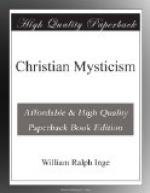[Footnote 288: Alejo Venegas in Rousselot, p. 78: Louis de Leon, who is indebted to the Fons Vitae.]
[Footnote 289: Louis de Leon: “The members and the head are one Christ.”]
[Footnote 290: Diego de Stella affirms the mystic paradox, that it is better to be in hell with Christ than in glory without Him (Medit. iii.).]
[Footnote 291: Juan d’Avila: “Let us put a veil between ourselves and all created things.”]
[Footnote 292: This side of Platonism appears in Pedro Malon, and especially in Louis de Granada. Compare also the beautiful ode of Louis de Leon, entitled “Noche Serena,” where the eternal peace of the starry heavens is contrasted with the turmoil of the world—
“Quien es el que esto mira,
Y precia la bajeza de la tierra,
Y no gime y suspira
Y rompe lo que encierra
El alma, y destos bienes la destierra?
Aqui vive al contento,
Aqui reina la paz, aqui asentado
En rico y alto asiento
Esta el amor sagrado
De glorias y deleites rodeado.”
]
[Footnote 293: After his release he was suffered to resume his lectures. A crowd of sympathisers assembled to hear his first utterance; but he began quietly with his usual formula, “Deciamos ahora,” “We were saying just now.”]
[Footnote 294: The heresy of the “Alombrados” (Illuminati), which appeared in the sixteenth century, and was ruthlessly crushed by the Inquisition, belonged to the familiar type of degenerate Mysticism. Its adherents taught that the prayers of the Church were worthless, the only true prayer being a kind of ecstasy, without words or mental images. The “illuminated” need no sacraments, and can commit no sins. The mystical union once achieved is an abiding possession. There was another outbreak of the same errors in 1623, and a corresponding sect of Illumines in Southern France.]
[Footnote 295: The real founder of Spanish quietistic Mysticism was Pedro of Alcantara (d. 1562). He was confessor to Teresa. Teresa is also indebted to Francisco de Osuna, in whose writings the principles of quietism are clearly taught. Cf. Heppe, Geschichte der quietistichen Mystik, p. 9.]
[Footnote 296: The fullest and best account of St. Teresa is in Mrs. Cunninghame Graham’s Life and Times of Santa Teresa (2 vols.).]
[Footnote 297: “Hae imaginariae visiones regulariter eveniunt vel incipientibus vel proficientibus nondum bene purgatis, ut communiter tenent mystae” (Lucern. Myst. Tract, v. 3).]
[Footnote 298: So in Plotinus [Greek: phantasia] comes between [Greek: physis] (the lower soul) and the perfect apprehension of [Greek: nous].]
[Footnote 299: St. Juan follows the mediaeval mystics in distinguishing between “meditation” and “contemplation.” “Meditation,” from which external images are not excluded, is for him an early and imperfect stage; he who is destined to higher things will soon discover signs which indicate that it is time to abandon it.]




